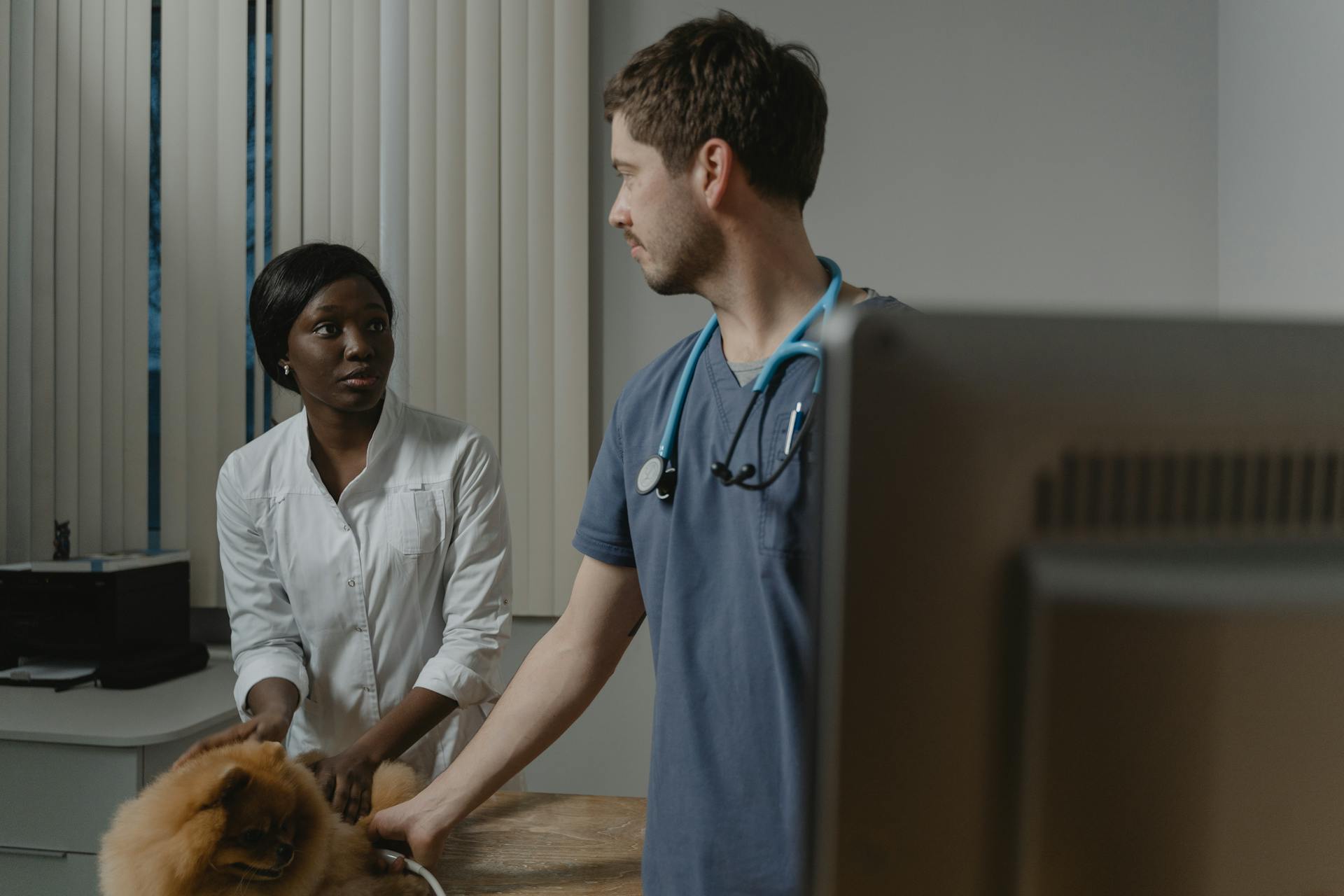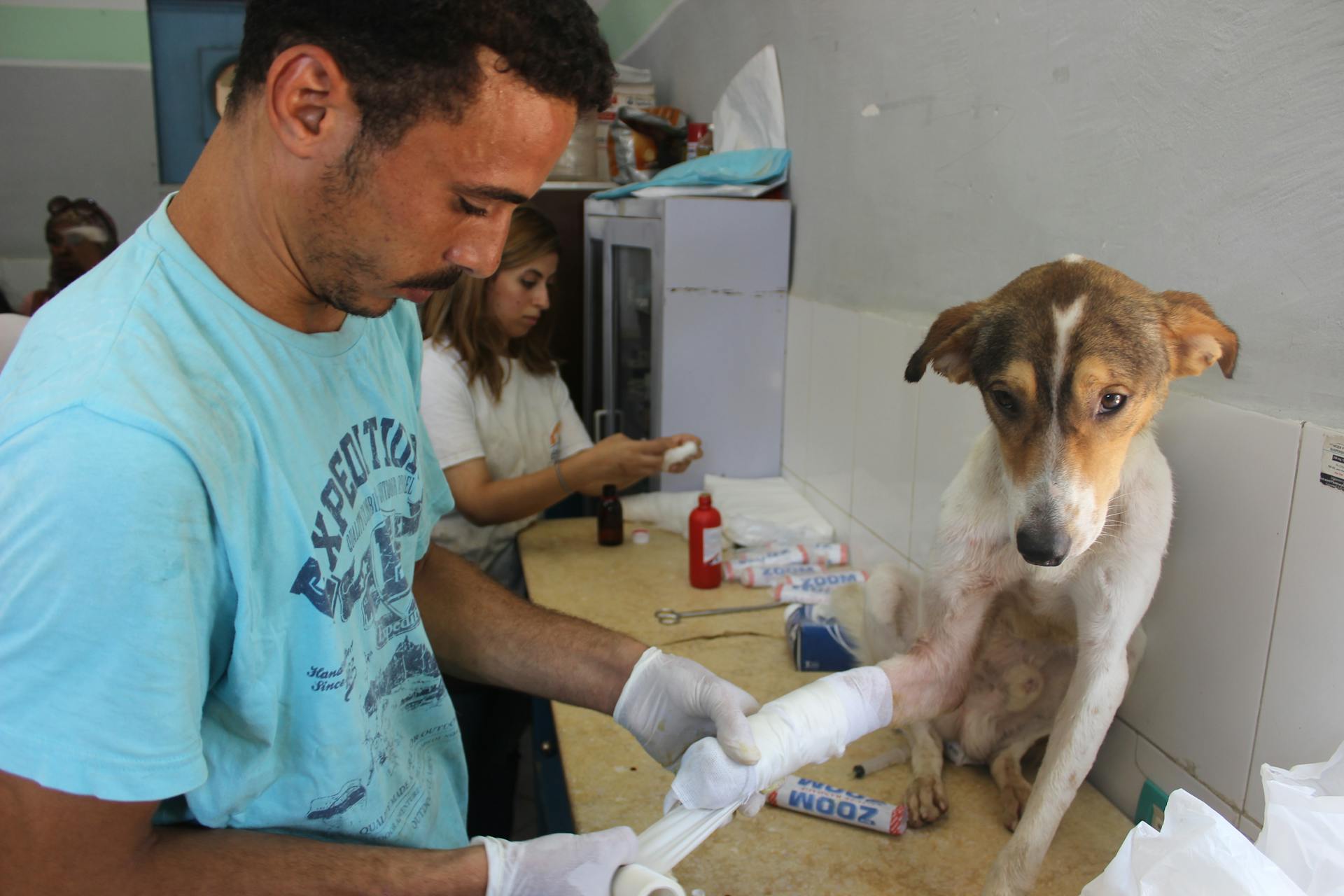
Dog reverse sneezing and gagging can be a distressing sight for any pet owner. Reverse sneezing, also known as inspiratory paroxysm, is a common condition in dogs.
It's estimated that up to 5% of dogs will experience a reverse sneeze at some point in their lives. The exact cause is often unclear, but it's thought to be related to an irritation or inflammation in the nasal passages.
Reverse sneezing can be triggered by a variety of factors, including allergies, colds, and even excitement or stress. In some cases, it can be a sign of a more serious underlying condition, such as a foreign object in the nasal passages.
Gagging, on the other hand, is a more forceful and intense version of reverse sneezing, often accompanied by a loud, high-pitched sound.
Consider reading: Dog Nasal Tumor Reverse Sneezing
What Causes?
Reverse sneezing in dogs can be caused by a variety of factors, including allergies to pollen and plants. These environmental factors can trigger an episode of reverse sneezing.
Dogs with long snouts are more prone to developing reverse sneezing than other dogs. However, any dog can potentially suffer from this problem, either once or as part of a chronic reverse sneezing condition.
Some common irritants that can trigger reverse sneezing include dust, nasal mites, seeds, grass, pollen, and smoke. These irritants can cause inflammation or irritation in the nasal, pharyngeal, or sinus passages.
Here are some common causes of reverse sneezing in dogs:
- Pollen, dust, cigarette smoke, or other irritants
- Secretions or mucous secondary to allergies, cold weather, infection, etc.
- Nasal mites
- Fungal infections
- Foreign objects such as grass awns (e.g. foxtails in dogs)
- Nasal tumors in dogs or other tumors in the back of the throat
- Irritation of the back of the throat due to acid reflux in dogs
- Excitement or pulling on the leash
- Eating or drinking rapidly
In some cases, dogs may experience reverse sneezing due to an unknown cause, which is referred to as idiopathic.
Diagnosis and Treatment
Reverse sneezing in dogs is usually a self-limiting condition, meaning it resolves on its own without the need for treatment. In most cases, your veterinarian will not prescribe medication or therapy.
Diagnosis Methods
Reverse sneezing in dogs is often diagnosed based on its characteristic appearance.
The vet may recommend additional diagnostics to rule out other medical conditions if needed.
What Is the Treatment for?

In most cases, reverse sneezing in dogs resolves on its own and doesn't require treatment.
If your dog's reverse sneezing persists or worsens, your veterinarian may prescribe certain medications or therapies.
Benadryl, an antihistamine, can sometimes help decrease the frequency of reverse sneezing in dogs, but it's essential to purchase plain Benadryl free from decongestants or cough suppressants.
Your veterinarian will guide you on whether Benadryl is a good option for your dog and ensure you use it safely.
A different take: Reverse Sneezing in Dogs Benadryl
Helping Your Dog
If your dog is experiencing a reverse sneezing episode, there are a few things you can do to help. Stay calm and upbeat, as your dog can pick up on your anxiety and stress.
Gently pet your dog to soothe them, but avoid petting their face or snout. This will help keep them calm and prevent panicking during the episode.
You can also try distracting your dog with a toy, treat, or dinner, or gently lifting their head up and then down. These actions can sometimes help stop the episode.
How to Help
If your dog is experiencing reverse sneezing, there isn't much you need to do except wait it out. Most episodes last only a minute or so and will resolve on their own.
If your dog seems distressed, gentle petting can help soothe them. However, avoid petting their face or snout, as they need to be able to breathe freely.
If this is the first time your dog has had a reverse sneezing episode, it's a good idea to take them to the vet to rule out other conditions. Even if the vet can't do much to help, it's better to be safe than sorry.
Your vet may prescribe antihistamines or decongestants if your dog's reverse sneezing is caused by allergies. But don't worry if they don't recommend medication – it just means the reverse sneezing isn't serious enough to require it.
To help your dog through a reverse sneezing episode, try staying calm and upbeat to reduce their anxiety. You can also try distracting them with a toy, treat, or dinner, or gently lifting their head up and down.
Here are some additional things you can try to help your dog:
- Massage their throat to help them swallow
- Keep them focused on enrichment toys and activities to avoid anxiety or overexcitement
- Avoid triggers like cigarette smoke, air fresheners, or fresh-cut grass if you can
Managing Cats
Cats may get anxious during an episode of reverse sneezing, so speak calmly and gently stroke their neck to help them relax.
You can also try hugging them or exposing them to cool air, such as standing in front of an open refrigerator or freezer.
Changing the environment by stepping outside or coming inside can help calm your cat.
Gently and lightly covering your cat's nose may stimulate the swallowing reflex and stop the reverse sneeze.
If your cat reverse sneezes frequently, for long periods of time, or has other signs, you should speak with your veterinarian.
You might like: Why Is My Cat Reverse Sneezing
When to Seek Help
If you have any concerns with how your dog is breathing after a reverse sneezing episode, don't hesitate to contact your vet.
If the episode seems to go on longer than a minute or two, it's best to seek veterinary help.
Contact your vet if you're unsure if the episode is reverse sneezing or not.
Sudden onset reverse sneezing that occurs frequently is a good reason to reach out to your vet for guidance.
Check this out: Vet Dogs Dog Treats
Understanding the Condition
A reverse sneeze in dogs is a phenomenon where the body pulls air through the nose and toward the lungs as the dog inhales forcefully.
The irritation that triggers a reverse sneeze is commonly found in the back of the nasal passages or the back of the dog's throat, specifically in the nasopharynx.
During a reverse sneeze, the dog rapidly draws air over the structures in the nose and throat, creating the characteristic reverse sneezing sound.
Intriguing read: Pomeranian Dog Sneeze
What Causes in Cats
So, what causes reverse sneezing in cats? The truth is, we don't know the exact cause, but it's believed to be triggered by irritation to the soft palate, nose, sinuses, or back of the throat.
Some possible irritants that could lead to this condition in cats include inhalation of foreign bodies, strong odors, and household chemicals. These can cause a hiccup-like spasm that results in reverse sneezing.
Other potential causes include viral or bacterial infections, fungal infections, and secretions like post-nasal drip. These can all irritate the sensitive areas in a cat's nose and throat.
It's worth noting that any cat can be affected by this condition, but it may be more common in certain breeds or individuals.
Collapsed Trachea vs
Collapsed trachea can be mistaken for reverse sneezing in dogs, but there's a key difference: with reverse sneezing, the dog pulls air in through the nose, whereas with a collapsed trachea, the dog expels air out of the mouth.
A collapsed trachea can sometimes be severe enough for a dog to go into respiratory distress, but dogs who are just reverse sneezing should not have any trouble breathing or turn blue.
The sound of a collapsed trachea is often described as a goose-honking cough, which can be similar to the sound of a reverse sneeze, but with a collapsed trachea, the dog's airway is obstructed, whereas with reverse sneezing, the airway is not blocked.
If your dog is experiencing a dry cough or goose-honking sound, it's essential to consult with a veterinarian to determine whether it's a collapsed trachea or reverse sneezing.
Here's an interesting read: Why Does My Dog Keep Gagging but Not Throwing Up?
What is?
A reverse sneeze is a similar concept but in reverse, typically caused by irritation in the back of the nasal passages or the back of the dog's throat.
Suggestion: American Bully Back Leg Problems
The irritation in the back of the nose and throat triggers a strong inhalation, forcing air through the nose and toward the lungs.
During a reverse sneeze, the dog rapidly draws air over the structures in the nose and throat, creating the characteristic reverse sneezing sound.
This sound is often loud and can be alarming, but it's usually a harmless condition that can be managed with some simple care.
Congestive Heart Failure
Congestive heart failure can be a serious condition in dogs, causing a range of symptoms that may seem unrelated at first.
Dogs with congestive heart failure may cough, which can sound like a reverse sneeze, but it's usually moist-sounding due to fluid in the lungs.
A large heart pressing in the trachea can also cause a dry cough in dogs with heart disease.
Reverse sneezing can make it harder for a dog with congestive heart failure to get enough oxygen, or even cause the dog to have a fainting spell.
It's essential to monitor your dog's behavior and health closely if you suspect congestive heart failure, as it can progress quickly and become life-threatening if left untreated.
Readers also liked: Can Dogs Sense a Heart Attack
Sources
- https://lakecityanimalhospital.com/blog/reverse-sneezing-in-dogs-causes-and-what-to-do/
- https://www.berkeleydogandcat.com/site/blog/2022/05/15/dog-reverse-sneeze
- https://canine-megaesophagus.com/reverse-sneezing-paroxysmal-respiration-gag-reflex/
- https://toegrips.com/reverse-sneezing-in-dogs/
- https://www.zoetispetcare.com/blog/article/reverse-sneezing-dogs-cats
Featured Images: pexels.com


